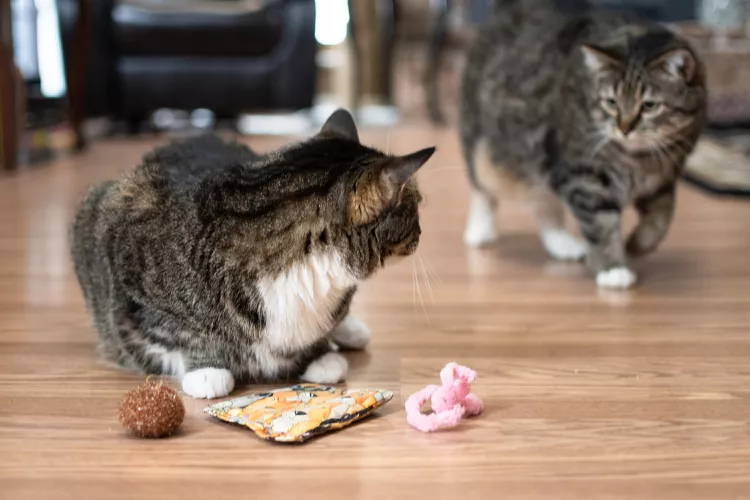
Cats will wrestle and play with each other and sometimes even get a little rough, but that can be normal cat behavior. Cats who live together and normally get along will exhibit non-painful ear biting, grabbing, and chasing as a part of their playful activities.
These behaviors develop when a cat is a very young kitten and are understood by other well-socialized cats. Cats who are not well-socialized may not know how to communicate with other cats, or sometimes dynamics arise within a multi-cat household and alter how even the most well-socialized cats interact with each other. Cats who start to show signs of dominance or anxiety can be challenging to work with, especially in multi-cat households.
Cats who are more dominant than other cats will display some specific behaviors depending on the situation they are in. Dominance in a cat can appear at a young age but it will become especially apparent once it matures or is about 2 to 4 years of age. This is the age cats typically will test their boundaries with other cats to establish a hierarchy.
Simple dominance will be exhibited by a cat by marking or spraying urine on territory, stealing and hoarding toys, rubbing its face on items it wants to claim as its own, claiming specific areas to sleep, pushing other cats away from the food bowl, and/or staring at or physically intimidating other cats. Cats who live alone may exhibit some of these behaviors too. A dominant cat that lives with other cats will have more obvious behaviors.
Dominant cats may attempt to establish their dominance in a multiple-cat household by hissing, hitting, and growling. They may also urinate outside of the litter box in areas that the other cats frequent, push other cats out of the food bowl until they are done eating, and make the other cats feel threatened. Dominant cats may also target sick cats in the house. Cats can sense and smell changes in other cats, often before the owner even knows about it. Therefore, they may be more aggressive and act out for no apparent reason towards a cat that isn't feeling well.
Stress can also trigger a cat to act out. For example, displaced aggression is often observed in multiple cat households when an indoor cat sees an outdoor cat through a window and takes out its anxiety on a cat in the home. Other major household changes may also cause this type of behavior, including the introduction of new pets or people, moving to a new home, and construction in the home.
Hierarchy can change with the introduction of a new cat or if you have several cats living together. Some cats will act dominantly in one room with one cat and suddenly switch roles in another room with another cat. Mannerisms from the dominant cat, such as excessive licking, standing on, or sitting on the other cat may be displayed, and swatting and even biting may occur.
While cats can be solitary animals, social hierarchies are also normal when many cats live in the same small area. Some cats are considered more dominant or more submissive, and this can be within the normal spectrum of cat behaviors. Additionally, socialization for kittens is an important part of learning how to navigate these interactions with other cats.
Kittens who don't have an opportunity to play and interact with litter mates or other cats may exhibit more extreme behaviors because they didn't learn from other cats. Feral kittens, kittens who need to fight for their food, and kittens who were bottle-fed and raised without other cats may also be more at risk for having undesirable behaviors. Finally, some cats can experience a behavior change related to stress or a medical problem, which can cause them to exhibit behaviors that are out of character for them.
Most people aren't able to oversee every life stage of their cats so it's hard to make sure the first eight weeks of a kitten's life don't contribute to or enforce these behaviors. But there are things a cat owner can do to decrease excessively dominant behaviors in their kitten or adult cat. Be sure to discourage overly aggressive play and don't allow your cat to bite or grab you. Redirect them to a toy they can bite or grab in place of using you or another cat for this purpose.
If you have multiple cats, be careful that you don't give one cat more attention than another, as this could lead to competition and/or jealousy. Feeding multiple cats in separate locations with separate bowls is also encouraged to decrease dominant behavior caused by competition for food. Additionally, it is important to make sure you have enough litter boxes for all of your cats to prevent them from competing or stalking each other in the litter box. This can lead to cats urinating outside of the litter box and/or marking. The general rule is to have at least one more litter box than you have cats and to ensure they are in private, quiet locations.
You should consult your veterinarian if you notice a sudden behavior change in one of your cats or escalating aggression toward cats or people. Some underlying medical conditions could lead to these changes and your veterinarian can help determine if there is a health problem. If the problem is strictly behavioral, working with your veterinarian as well as a trainer can be the best way to help your cat and reestablish harmony in your home.
Positively reinforcing good behaviors is better than trying to punish a cat. When your cats are spending time together, be sure to give them treats and pet them. Play with them together while giving them treats and verbally praise them if they are getting along well. This will reinforce the type of behaviors you want to see in your cats, even if one of them is more dominant or pushy than the other.

Cute Pictures & Facts About Calico Cats & Kittens
Learn fascinating facts about calico cats, including photos, the genetics behind this color combination, and common folklore and traditions.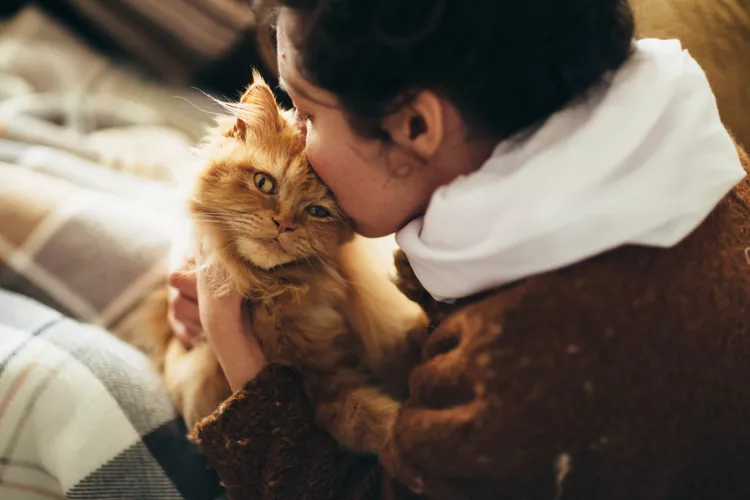
How to Prevent Cat Separation Anxiety During Vacations
Discover why cats develop litter box problems and cat behavior problems when you go on vacation and what you can do about it to help them.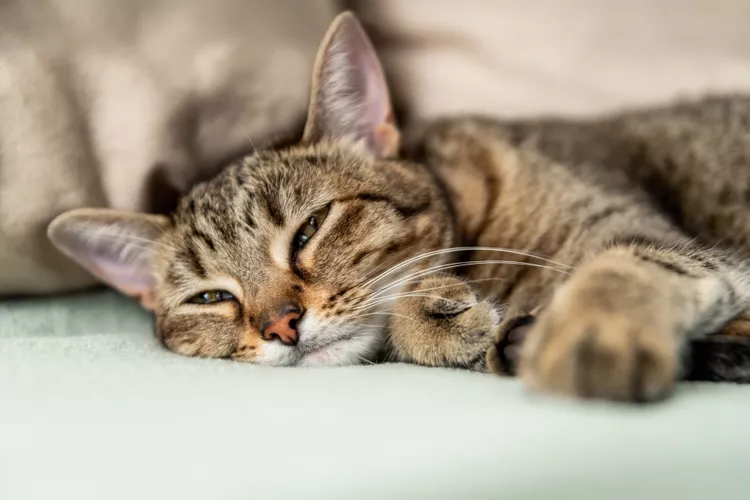
Cat Behavior Changes That Might Mean Something's Wrong
Cats' behavioral changes may indicate problems—or they may mean nothing at all. Explore causes of odd behavior and what to do about them.
Lhasa Apso: Dog Breed Characteristics & Care
The Lhasa apso is an ancient breed from Tibet that was bred to be a watchdog. Learn about its history, health, exercise needs, and more.
Reasons Why Dogs Run Away and How to Stop It
Dogs can escape, especially if they’re bored and not properly contained. Here are some techniques for stopping your dog from running away.
Can Dogs Get Depression? How to Help Your Sad Dog
Can dogs get depression? Learn about the signs of depression in dogs and find out how to help your sad dog.
How to Stop Aggression in Dogs
Dog aggression can be a serious behavior issue for pet owners. Learn how to stop aggression in dogs before someone gets hurt.
How to Stop Your Dog From Growling
A growling dog can soon become even more aggressive. Reduce the noise and potential for a dangerous situation with some of these techniques.
Why Do Dogs Dig Holes? How to Stop Your Dog from Relandscaping Your Yard
Dogs have been digging holes for centuries and for many reasons. Whether they’re bored or want to cool off in the dirt, here are the top reasons why dogs dig holes.
Dog Treat Varieties
Learn about the different types of dog treats on the market and decide which are best for your dog.
Can Dogs Eat Asparagus?
Dogs can eat asparagus, provided the vegetable is cooked plain and cut up for them. Seasonings, salt, and butter make it unhealthy for dogs.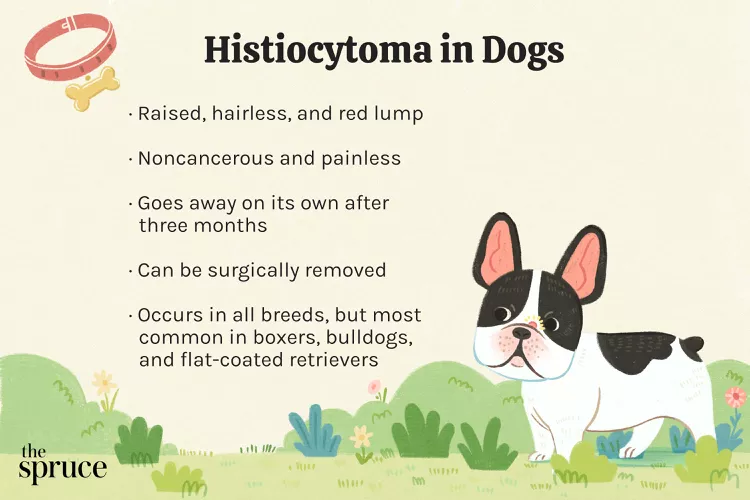
Histiocytomas in Dogs
A histiocytoma is a type of benign (non-cancerous) skin lump that usually affects young dogs. Learn the causes, treatment, and prevention.
Why Is My Dog’s Eye Swollen?
If your dog's eye is swollen, she may need veterinary attention. The inflammation could be caused by allergies, an injury, or even a tumor.
Common Bugs and Parasites Found on and Inside Dogs
Learn about common types of parasites in dogs. Find out how to treat and prevent parasites to keep your dog, your family, and yourself safe.
Exploring the Different Types of Pet-Friendly Beaches
Are you looking for pet-friendly beaches? Learn about the different types of pet-friendly beaches, their locations, and tips for visiting them with your pet.
10 Obscure, Little-known Canine Facts in Honor of National Dog Day
With National Dog Day upon us, it's time to celebrate everything about our favorite pets—even the weirder stuff. Here are 10 obscure facts about dogs you probably didn't know.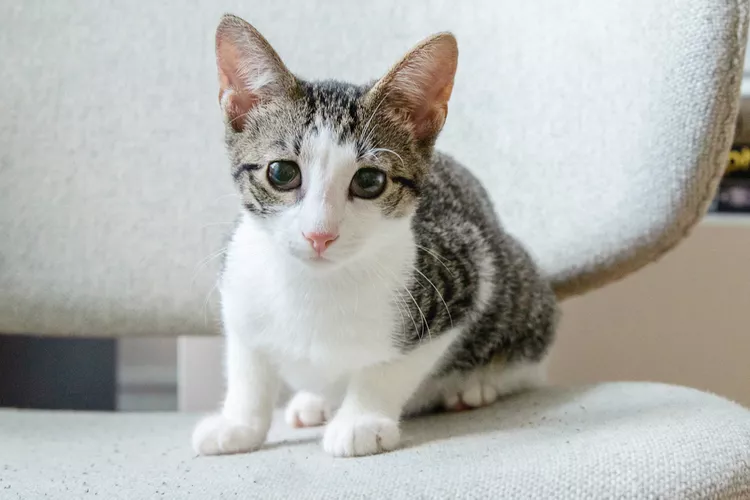
Kitten Development From 3 to 6 Months Old
Kittens grow and change a lot during their first year. Find out what happens between the ages of three months and six months old.
95 Siamese Cat Names
Our list of Siamese cat names has diverse and fun options to help you choose the ideal moniker for your elegant and lovable feline companion.
What to Buy for Your New Cat: A List of Essentials
Before you bring your new cat or kitten home, there are a number of things to collect or buy so your cat will feel welcomed like a family member.
The 6 Best Cat Nail Clippers of 2024 for a Safe Trim
Clipping your cat's nails can save your furniture and keep your kitty comfortable. We asked veterinarians for their cat nail clipper recommendations.